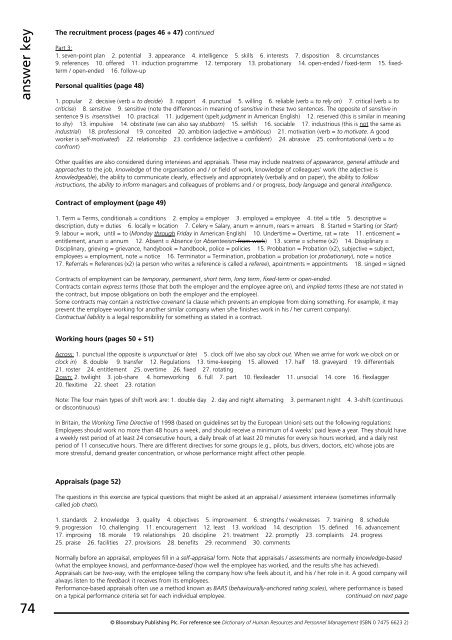HUMAN RESOURCES
check your english vocabulary for
check your english vocabulary for
Create successful ePaper yourself
Turn your PDF publications into a flip-book with our unique Google optimized e-Paper software.
answer key<br />
The recruitment process (pages 46 + 47) continued<br />
Part 3:<br />
1. seven-point plan 2. potential 3. appearance 4. intelligence 5. skills 6. interests 7. disposition 8. circumstances<br />
9. references 10. offered 11. induction programme 12. temporary 13. probationary 14. open-ended / fixed-term 15. fixedterm<br />
/ open-ended 16. follow-up<br />
Personal qualities (page 48)<br />
1. popular 2. decisive (verb = to decide) 3. rapport 4. punctual 5. willing 6. reliable (verb = to rely on) 7. critical (verb = to<br />
criticise) 8. sensitive 9. sensitive (note the differences in meaning of sensitive in these two sentences. The opposite of sensitive in<br />
sentence 9 is insensitive) 10. practical 11. judgement (spelt judgment in American English) 12. reserved (this is similar in meaning<br />
to shy) 13. impulsive 14. obstinate (we can also say stubborn) 15. selfish 16. sociable 17. industrious (this is not the same as<br />
industrial) 18. professional 19. conceited 20. ambition (adjective = ambitious) 21. motivation (verb = to motivate. A good<br />
worker is self-motivated) 22. relationship 23. confidence (adjective = confident) 24. abrasive 25. confrontational (verb = to<br />
confront)<br />
Other qualities are also considered during interviews and appraisals. These may include neatness of appearance, general attitude and<br />
approaches to the job, knowledge of the organisation and / or field of work, knowledge of colleagues' work (the adjective is<br />
knowledgeable), the ability to communicate clearly, effectively and appropriately (verbally and on paper), the ability to follow<br />
instructions, the ability to inform managers and colleagues of problems and / or progress, body language and general intelligence.<br />
Contract of employment (page 49)<br />
1. Term = Terms, conditionals = conditions 2. employ = employer 3. employed = employee 4. titel = title 5. descriptive =<br />
description, duty = duties 6. locally = location 7. Celery = Salary, anum = annum, rears = arrears 8. Started = Starting (or Start)<br />
9. labour = work, until = to (Monday through Friday in American English) 10. Undertime = Overtime, rat = rate 11. enticement =<br />
entitlement, anum = annum 12. Absent = Absence (or Absenteeism from work) 13. sceme = scheme (x2) 14. Dissiplinary =<br />
Disciplinary, grieving = grievance, handybook = handbook, police = policies 15. Probbation = Probation (x2), subjective = subject,<br />
employees = employment, note = notice 16. Terminator = Termination, probbation = probation (or probationary), note = notice<br />
17. Referrals = References (x2) (a person who writes a reference is called a referee), apointments = appointments 18. singed = signed<br />
Contracts of employment can be temporary, permanent, short term, long term, fixed-term or open-ended.<br />
Contracts contain express terms (those that both the employer and the employee agree on), and implied terms (these are not stated in<br />
the contract, but impose obligations on both the employer and the employee).<br />
Some contracts may contain a restrictive covenant (a clause which prevents an employee from doing something. For example, it may<br />
prevent the employee working for another similar company when s/he finishes work in his / her current company).<br />
Contractual liability is a legal responsibility for something as stated in a contract.<br />
Working hours (pages 50 + 51)<br />
Across: 1. punctual (the opposite is unpunctual or late) 5. clock off (we also say clock out. When we arrive for work we clock on or<br />
clock in) 8. double 9. transfer 12. Regulations 13. time-keeping 15. allowed 17. half 18. graveyard 19. differentials<br />
21. roster 24. entitlement 25. overtime 26. fixed 27. rotating<br />
Down: 2. twilight 3. job-share 4. homeworking 6. full 7. part 10. flexileader 11. unsocial 14. core 16. flexilagger<br />
20. flexitime 22. sheet 23. rotation<br />
Note: The four main types of shift work are: 1. double day 2. day and night alternating 3. permanent night 4. 3-shift (continuous<br />
or discontinuous)<br />
In Britain, the Working Time Directive of 1998 (based on guidelines set by the European Union) sets out the following regulations:<br />
Employees should work no more than 48 hours a week, and should receive a minimum of 4 weeks' paid leave a year. They should have<br />
a weekly rest period of at least 24 consecutive hours, a daily break of at least 20 minutes for every six hours worked, and a daily rest<br />
period of 11 consecutive hours. There are different directives for some groups (e.g., pilots, bus drivers, doctors, etc) whose jobs are<br />
more stressful, demand greater concentration, or whose performance might affect other people.<br />
Appraisals (page 52)<br />
The questions in this exercise are typical questions that might be asked at an appraisal / assessment interview (sometimes informally<br />
called job chats).<br />
1. standards 2. knowledge 3. quality 4. objectives 5. improvement 6. strengths / weaknesses 7. training 8. schedule<br />
9. progression 10. challenging 11. encouragement 12. least 13. workload 14. description 15. defined 16. advancement<br />
17. improving 18. morale 19. relationships 20. discipline 21. treatment 22. promptly 23. complaints 24. progress<br />
25. praise 26. facilities 27. provisions 28. benefits 29. recommend 30. comments<br />
74<br />
Normally before an appraisal, employees fill in a self-appraisal form. Note that appraisals / assessments are normally knowledge-based<br />
(what the employee knows), and performance-based (how well the employee has worked, and the results s/he has achieved).<br />
Appraisals can be two-way, with the employee telling the company how s/he feels about it, and his / her role in it. A good company will<br />
always listen to the feedback it receives from its employees.<br />
Performance-based appraisals often use a method known as BARS (behaviourally-anchored rating scales), where performance is based<br />
on a typical performance criteria set for each individual employee.<br />
continued on next page<br />
© Bloomsbury Publishing Plc. For reference see Dictionary of Human Resources and Personnel Management (ISBN 0 7475 6623 2)





